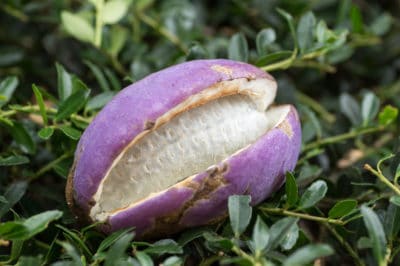How do the fruits of the Akebia quinata look like?
As the name climbing cucumber suggests, the fruits of the Akebia look quite similar to a cucumber. They are finger-shaped and about 15 centimetres long. However, their colour is quite unusual for cucumbers, as is their sweet taste. The colouring is called blue tires or violet and resembles rather that of an eggplant.
The most important thing in a nutshell:
- Fruits edible
- sweet taste
- Size: approx. 15 cm
shape: finger-shaped, cucumber-like
- colour: violet or purple, blue tyres
Under what conditions do the fruits ripen?
Since the Akebia quinata belongs to the tropical plants, it needs warmth and sun to bear flowers and later fruits. In addition, it begins to flower only at the age of approximately five years. So, with a young Akebie, fruits are not yet to be expected. On older Akebien you can harvest in September or October.
Do all blossoms of the Akebie develop fruit?
An Akebia quinata bears both male and female flowers, but only the female flowers develop fruit. These flowers are brownish violet and smell of vanilla or chocolate. They are slightly larger than the male flowers, which you can easily recognise by their pink colour. For a successful fertilization it makes sense to plant at least two akebien.
Which parts of the Akebia quinata are culinary suitable?
In addition to the sweet, slightly chocolate-tasting fruits, you can also use the sprouts and leaves in the kitchen. The skin of the fruit tastes rather bitter, by the way. They are nevertheless fried and eaten in their Asian homeland.
A tea can be made from the (dried) leaves of the Akebia quinata. The young sprouts can also be eaten raw and prepared, for example, in a salad. The Akebia is said to have a analgesic and diuretic effect. It is supposed to protect the stomach and prevent urinary tract infections.
Hint
Even without wanting to benefit medically, the fruit is a culinary experience.
